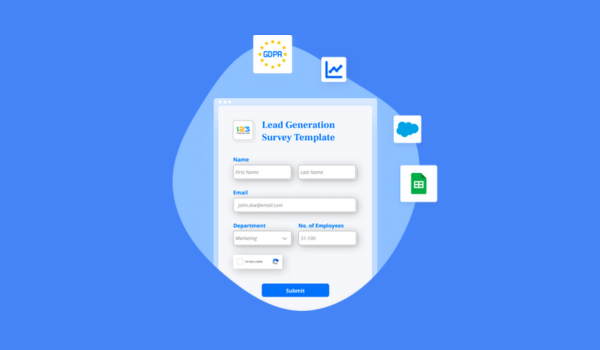Best Practices for Designing Lead-Generating Online Forms in Education
Within the competitive educational sphere, efficiently generating prospective student leads is vital for the advancement and endurance of institutions. Colleges and universities consistently explore inventive approaches to entice potential students and direct their enthusiasm into enrolments. One of the most powerful tools in the age of digitization is the online form.

Well-designed online forms can greatly improve lead generation endeavours by gathering the required data from prospective students effectively. This article delineates efficient design tactics for online forms that can raise lead generation for colleges and universities. By leveraging affordable dissertation writing services, educational institutions can access expert guidance on optimizing their online forms to maximize lead generation potential and attract a diverse pool of prospective students.
Understanding Lead Generation in Education
Lead generation for education involves identifying and nurturing prospective students for college and university programs. It’s a systematic approach that includes collecting inquiries from potential students and guiding them through the enrollment process. Effective lead acquisition strategies are crucial for maintaining a steady flow of students and ensuring the long-term success of educational institutions. Incorporating tools like cloud practice tests can also help prospective students prepare effectively, making the lead generation process even more impactful.
The Importance of Online Forms
Online forms are the primary tool for gathering information from interested individuals, making their design and functionality pivotal. A well-constructed form not only collects data but also enhances the user experience, encouraging completion and submission. These forms are key in implementing strategies to increase student enrolment and are critical for achieving sustained growth in student numbers.
Best Practices for Form Design
Keep It Simple and Intuitive
The cardinal rule of online form design is to keep it simple, especially when it comes to lead generation for higher education. Overly complicated or lengthy forms can deter potential leads from completing the process. Forms should be concise, asking only for essential information such as name, contact details, and area of interest. This approach respects the user's time and increases the likelihood of form completion, which is crucial in efficiently capturing information from prospective students in the competitive higher education sector.
Use Conditional Logic to Streamline the Process
Conditional logic in forms assists in revealing or obscuring form fields derived from the user’s earlier replies. This intelligent function can streamline intricate forms by customizing the questions to the user’s particular interests or past responses, thus circumventing superfluous or extraneous inquiries. For instance, if a potential student demonstrates an interest in undergraduate programs, the form will only showcase applicable fields linked to undergraduate studies.

Optimize for Mobile Users
With a growing number of users using mobile devices to access the internet, it's imperative to make sure that online forms are suitable for mobile use. Incorporating responsive design is indispensable to promoting easy navigation and usability of forms on smartphones and tablets, thus enlarging the scope and approachability of your lead generation endeavours.
Ensure Security and Privacy
Prospective students are more likely to provide personal information if they trust the security and privacy of the form. It's important to use secure form protocols (HTTPS) and to clearly state privacy policies regarding how the data will be used. This transparency builds trust and complies with data protection regulations.
Enhancing Engagement Through Design
Use Attractive Visual Elements
The visual appeal of an online form can significantly affect completion rates. Using attractive elements such as branded colours, readable fonts, and an overall clean layout can make the form inviting and professional. These elements should align with the institution’s branding to provide a consistent user experience.
Provide Clear Calls to Action
The call to action (CTA) on a form should be clear and compelling. It should encourage the user to take the next step, whether that is to “Apply Now,” “Download a Brochure,” or “Schedule a Campus Visit.” The CTA button should be prominently displayed and designed in a colour that stands out from the rest of the form.

Leveraging Forms for Enhanced Lead Generation
Integrating with Marketing Tools
For effective lead management, online forms should integrate seamlessly with marketing automation tools and CRM systems. This integration allows for the immediate capture and segmentation of data, facilitating timely and relevant follow-up communications, which are crucial in converting leads into students.
Analyse and Iterate
Continuously testing and analysing the performance of online forms can provide insights into user behaviour and preferences. A/B testing different versions of a form can help determine which elements are most effective in driving submissions.
Utilizing Professional Services
For institutions looking to optimize their content strategy further, employing professional services such as affordable dissertation writing services like EssayPay can enhance the quality of the resources offered to prospective students, helping to establish credibility and attract higher-quality leads.
Conclusion
Online forms are a vital component of lead generation strategies in the education sector. By following these design tips, institutions can create effective online tools that not only gather data but also enhance the prospective student’s journey from initial interest to application. Understanding how to generate leads for education is crucial.
Colleges and universities must also provide clear, straightforward pathways for students to express interest and seek information, ensuring a smooth transition into higher education. This strategic approach helps institutions effectively attract and engage prospective students, which is vital for sustaining and growing their educational programs.





